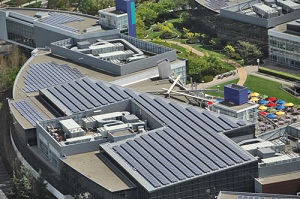Guest Editorial: The future of solar: Not Solyndra. Not China. But the USA.
 The future of solar is not in China. They are the present: 185 Chinese solar panel makers relentlessly driving down costs by 30 percent a year.
The future of solar is not in China. They are the present: 185 Chinese solar panel makers relentlessly driving down costs by 30 percent a year.
The future of solar is right here in America, using smart technology to get the most out of what the Chinese sell us.
That is not as easy—or as bad—as it sounds.
Twenty years ago, nuclear power plants were running at 50 percent of capacity. For all the theory about making energy too cheap to meter, the nuclear industry was better at building plants than actually making them generate power.
They figured it out. Today nuclear power plants in the United States run at 90 percent capacity.
Solar today is where nuclear was: Solar plants are not producing energy as well as they could.
Google was among the first to find out.
In 2007, Google built a 1.65-megawatt solar energy system. That is about two football fields with about 10,000 panels.
In 2009, Google did an experiment where it doubled the energy it was getting from its panels: Google cleaned them. Eight months later, Google cleaned them again and increased energy by 37 percent.
The people at Google are just about the smartest and most forward-thinking on earth. They had no problem admitting how little they knew about their own system.
Google figured out that 10,000 panels are really 10,000 separate energy generating systems. But like most everyone else, Google used one monitor to add up the energy from all 10,000 panels. But they had no information about how individual panels were performing –if at all.
When energy output went down, they did not know if it was due to bad panels, hungry raccoons, errant golf balls, bad wires, hot roofs, dirty dirt, clouds, or any of the other thousand natural shocks solar systems are heir to.
They were guessing. And Google knew it.
It would be difficult to detect manufacturer defects or accidental damage by data analysis alone, unless the damage impacts more than 20 percent of the solar panels in that building.
Translation: They knew when the panels were on and when they were off. And that is about it. If you can’t measure it, you can’t manage it.
Every business student learns that on day one. Solar managers know it too. But until recently, they did not have the tools to see what was going on in their larger solar arrays. That is changing.
And as that spreads through the industry, that will be like adding free energy capacity.
That is just one example of how the future is blooming. We are starting to learn how much we can improve the way we distribute power in smart grids. Or how we use energy around the house and in our cars. And when alternative energy is the solution. Or not. And how water and energy are connected, and if we conserve one, we save the other.
Solar and alternative energy today is a new business—really only about five years old. Solyndra and poor panel performance are history.
Making it better is our future, right now.
Pictured: Google's rooftop solar installation.
Ray Burgess is CEO of Solar Power Technologies Inc., based out of Austin, Texas, which provides power optimization, monitoring and control systems for commercial and utility scale solar power sites.



